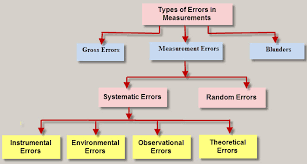True
Value:
It is not possible to determine the true of quantity by experiment
means. True value may be defined as the average value of an infinite number of
measured values when average deviation due to various contributing factor will
approach to zero.
Measured
Value:
It may be defined as the approximated value of true value. It can be
found out by taking means of several measured readings during an experiment, by
applying suitable approximations on physical conditions. Now we are in a
position to define static error. Static error is defined as the difference of
the measured value and the true value of the quantity. Mathematically we can
write an expression of error as, dA = Am - At where, dA is the static error Am is measured value and At is true value. It may be noted that the absolute value of error cannot be determined as
due to the fact that the true value of quantity cannot be determined accurately. Let us consider few terms related to errors.
Types of Errors:
Basically there are
three types of errors on
the basis; they may arise from the source.
Gross Errors:
This
category of errors includes all the human mistakes while reading, recording and
the readings. Mistakes in calculating the errors also come under this category.
For example while taking the reading from the meter of the instrument he may
read 21 as 31. All these types of error are come under this category. Gross
errors can be avoided by using two suitable measures and they are written
below:
1. A proper care should be
taken in reading, recording the data. Also calculation of error should be done
accurately.
2. By increasing the number of
experimenters we can reduce the gross errors. If each experimenter takes
different reading at different points, then by taking average of more readings
we can reduce the gross errors.
Systematic Errors:
In order to
understand these kinds of errors, let us categorize the systematic errors as
Instrumental Errors:
These errors may be due to wrong construction, calibration of the measuring instruments. These
types of error may be arises due to friction or may be due to hysteresis. These
types of errors also include the loading effect and misuse of the instruments.
Misuse of the instruments results in the failure to the adjust the zero of
instruments. In order to minimize the gross errors in measurement various
correction factors must be applied and in extreme condition instrument must be
re-calibrated carefully.
Environmental Errors:
This
type of error arises due to conditions external to instrument. External
condition includes temperature, pressure, humidity or it may include external magnetic
field. Following are the steps that one must follow in order to minimize the
environmental errors:
·
Try
to maintain the temperature and humidity of the laboratory constant by making
some arrangements.
·
Ensure
that there should not be any external magnetic or electrostatic field around
the instrument.
Observational Errors:
As the name suggests these types of errors are due wrong observations. The wrong
observations may be due to PARALLAX. In order to minimize the PARALLAX error
highly accurate meters are required, provided with mirrored scales.
Random Errors:
After calculating all systematic errors, it is found that there are
still some errors in measurement are left. These errors are known as random
errors. Some of the reasons of the appearance of these errors are known but
still some reasons are unknown. Hence we cannot fully eliminate these kinds of
error.












0 comments:
Post a Comment